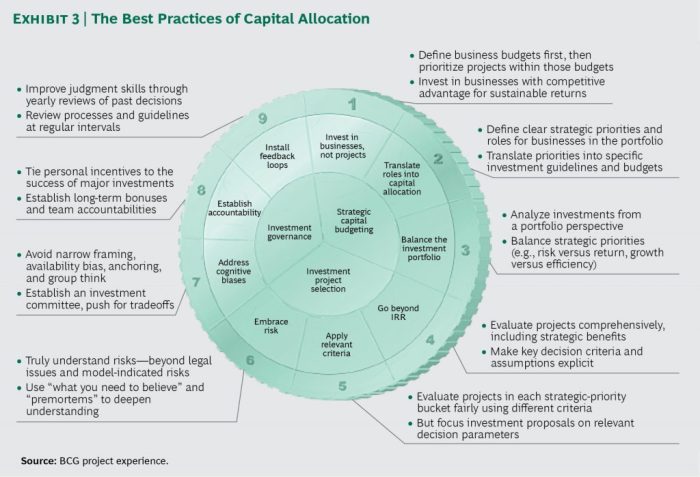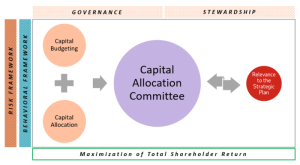
Embark on a journey into the realm of Best Practices in Capital Allocation, where strategic decisions drive business success and growth.
Explore the nuances of capital allocation, from key factors to successful strategies that pave the way for sustainable expansion.
Definition of Capital Allocation
Capital allocation in the context of finance and business refers to the process of distributing financial resources across different areas or projects within a company. It involves deciding how much capital should be allocated to each project or business unit to maximize returns and achieve strategic objectives.
Effective capital allocation is crucial for businesses as it helps in optimizing the use of funds, minimizing risks, and enhancing overall performance. By strategically allocating capital, companies can prioritize investments that offer the highest potential for growth and profitability while also ensuring efficient use of resources.
Importance of Strategic Capital Allocation
One of the key reasons why strategic capital allocation is important for businesses is that it ensures that resources are allocated to projects that align with the company’s goals and objectives. This helps in driving growth, increasing profitability, and creating long-term value for stakeholders.
- Strategic capital allocation allows businesses to focus on investments that have the potential to generate high returns and create a competitive advantage in the market.
- It helps in avoiding the misallocation of resources and ensures that capital is deployed in a way that maximizes shareholder value.
- By prioritizing projects with the highest potential for success, companies can mitigate risks and improve their overall financial performance.
Examples of How Effective Capital Allocation Can Drive Growth
Several companies have demonstrated the power of effective capital allocation in driving growth and creating value for their stakeholders. Here are some examples:
“Apple’s strategic capital allocation decisions, such as investing in research and development for innovative products and returning excess cash to shareholders through dividends and share buybacks, have contributed to its growth and success in the technology industry.”
“Amazon’s focus on investing in areas with high growth potential, such as cloud computing and logistics, has allowed the company to expand its market presence and deliver strong financial performance.”
Factors Influencing Capital Allocation Decisions
Capital allocation decisions are crucial for the success of any organization, as they determine how resources are distributed among various projects or investments. Several key factors can influence these decisions, including risk assessment and market conditions.
Risk Assessment
Risk assessment plays a vital role in capital allocation decisions. Before allocating capital to any project or investment, it is essential to assess the risks involved. This involves evaluating the potential risks and rewards of each opportunity to make informed decisions. By considering factors such as market volatility, competition, regulatory changes, and internal capabilities, companies can better allocate capital to minimize risks and maximize returns.
Impact of Market Conditions
Market conditions also have a significant impact on capital allocation strategies. Fluctuations in the market, changes in consumer behavior, economic trends, and geopolitical events can all affect the performance of investments. In response to these factors, companies may need to adjust their capital allocation decisions to capitalize on opportunities or mitigate risks. By staying informed about market conditions and being flexible in their approach, organizations can adapt their capital allocation strategies to optimize returns in different market environments.
Best Practices in Capital Allocation

Efficient capital allocation is crucial for the success and growth of any business. By deploying capital strategically, companies can maximize returns and minimize risks. Here are some best practices to consider:
1. Setting Clear Objectives
- Establish specific goals and objectives for capital allocation.
- Align these objectives with the overall business strategy.
- Ensure that all stakeholders are aware of and understand the objectives.
2. Conducting Thorough Analysis
- Utilize financial data and market research to inform capital allocation decisions.
- Assess the potential risks and returns associated with each investment opportunity.
- Consider both short-term and long-term implications of capital allocation choices.
3. Implementing a Diversified Approach
- Diversification plays a key role in optimizing capital allocation.
- Allocate capital across different asset classes, industries, and geographic regions.
- By diversifying investments, companies can reduce overall risk exposure.
4. Monitoring and Adjusting
- Regularly review and assess the performance of capital allocation decisions.
- Adjust allocations as needed based on changing market conditions or business goals.
- Implement a feedback loop to continuously improve the capital allocation process.
Relationship Between Capital Allocation and Capital Growth

Strategic capital allocation plays a crucial role in driving capital growth for businesses. By effectively distributing resources to areas that generate the highest returns, companies can maximize their growth potential and enhance overall profitability.
Importance of Aligning Capital Allocation with Growth Objectives
It is essential for organizations to align their capital allocation decisions with their growth objectives to ensure that resources are utilized efficiently. By investing in projects and initiatives that support long-term growth strategies, companies can sustainably expand their operations and increase market share.
- Allocating capital towards research and development activities can lead to the introduction of innovative products and services, driving revenue growth and market competitiveness.
- Investing in expanding existing facilities or acquiring new assets can facilitate business expansion into new markets, contributing to overall growth and profitability.
- Allocating resources towards strategic partnerships or mergers and acquisitions can enable companies to access new capabilities and markets, accelerating growth opportunities.
Effective Capital Allocation for Sustainable Growth
When companies prioritize effective capital allocation practices, they can achieve sustainable growth and long-term success in the market. By focusing on investments that generate high returns and align with the company’s strategic objectives, organizations can create value for shareholders and stakeholders.
Optimizing capital allocation by balancing risk and return can help companies achieve sustainable growth while managing financial resources efficiently.
- Implementing a robust capital allocation framework that evaluates investment opportunities based on their potential impact on growth can ensure that resources are allocated to projects with the highest growth potential.
- Regularly reviewing and adjusting capital allocation strategies in response to changing market conditions and business priorities can help companies adapt to dynamic environments and seize growth opportunities.
In conclusion, mastering the art of capital allocation is paramount for businesses aiming to thrive amidst evolving market landscapes.
FAQ Resource
How can effective capital allocation drive growth?
By strategically allocating resources to high-return projects, businesses can fuel growth and maximize returns.
What role does diversification play in capital allocation?
Diversification helps mitigate risks by spreading investments across different asset classes, enhancing overall portfolio stability.






